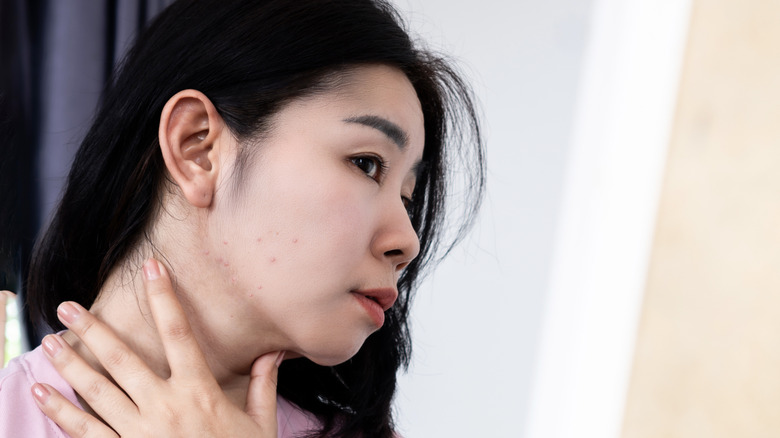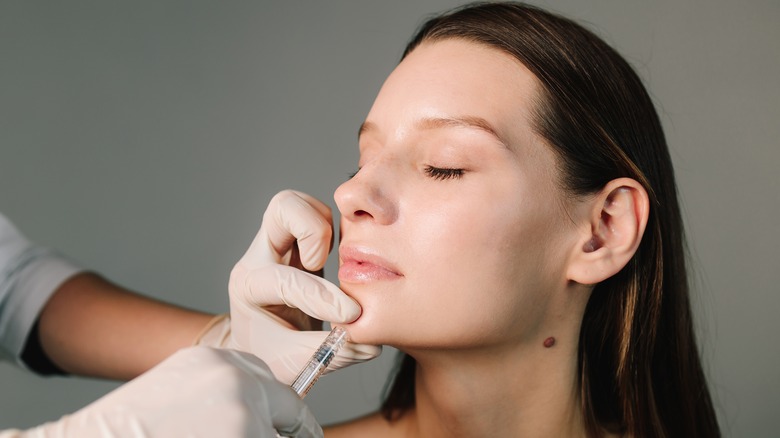Does Chewing Gum Sculpt Your Jawline? Here's What To Know
Spend long enough on TikTok and you'll come across all kinds of tips to enhance your face. Mouth taping, microneedling, gua sha: these methods have been co-opted into the "looksmaxxing" trend. Originally a men's movement that began on obscure Reddit forums as a strategy to attract women, it has trickled into the mainstream and found fertile ground on TikTok across all users, regardless of gender. With phone cameras bringing faces up close and personal, physical appearance has now become an axiomatic metric of success on the platform. This all fits a very narrow definition of beauty, of course — one that prioritizes symmetry, sharp angles, and homogenous, exaggerated features often unattainable without cosmetic intervention. The jawline has become a prime target, with the goal being angularity. One curious hack gaining traction is chewing gum as a shortcut to the so-called perfect jawline, but two experts have agreed it's nothing more than a myth.
Women exclusively spoke with Dr. Erin Fraundorf, a board-certified orthodontist from St. Louis. With her years of expertise, she shares, "There is no currently no scientific evidence that supports these claims that chewing gum can strengthen your jaw or lead to a more sculpted jawline." Similarly, Women also spoke with Dr. Michael Niccole of California's renowned plastic surgery clinic CosmetiCare, who compares the practice to lifting weights: "Chewing gum builds muscle in the cheeks, which can cause them to protrude. However, this has no impact on sculpting or chiseling the jawline, making the claim absolutely false."
There are lots of risks to jawline-shaping gum
Not only are assertions about gum's proportioning capacity false, but they are also potentially harmful. With the rise of specialized rock-hard gum being promoted on social media, Dr. Erin Fraundorf points to its several risks, including jaw popping and clicking, headaches, bite issues, and tooth misalignment, mobility, and wear (not to mention the susceptibility to cavities if the gum contains sugar). She advises anyone considering at-home orthodontic or dental fixes to consult a professional, adding, "An orthodontist can work with you to answer any questions you may have and safely address your concerns." Backed by extensive education in the field, these professionals are uniquely qualified and equipped to deal with the movement of teeth, jawbones, facial bones, and soft tissue.
Dr. Michael Niccole raises another valid concern, noting that excessive gum chewing could leave you with unintended etiquette faux pas. He says: "It's often considered socially inappropriate in settings like meetings or classrooms, especially if done with an open mouth." After all, what are good looks without good manners to match?
Does mewing help?
As another way to achieve a desirable jawline (desirable, at least, by the media-imposed standards of Western beauty), the "mewing" fad has also built up some steam. For those who haven't heard, this is a do-it-yourself, non-medical technique aimed to enhance facial features by pressing the tongue against the roof of the mouth. This promises to alter the shape of the jawline, even eliminating the much-maligned double chin. Dr. Erin Fraundorf explains that mewing was named after its originators, John Mew and his son, Dr. Michael Mew, respectively a former and current orthodontist in England. Dr. Fraundorf shares, "John practiced, beginning in the 1970s, what he termed 'orthotropics,'" which the pair claims is "an alterantive approach to orthodontic treatment, meaning 'correct growth.'" Their theories on oral posture training have no scientific evidence behind them, and since then, John Mew has had his medical license revoked by the General Dental Council of Britain for controversial practices. Michel Mew was also expelled from the British Orthodontic Society for his "unhealthy obsession with publicity to the detriment of patients."
There are alternatives, though they are more drastic
With two of TikTok's favorite hacks both out of the question, many keen looksmaxxers are wondering if there are actually any effective practices to achieve a more contoured jawline. According to Dr. Michael Niccole, the most natural approach is weight loss, which "reduces fat around the face, allowing the bone structure to become more prominent." The models we see on social media, he reminds us, "often have a chiseled appearance due to being at a very low weight where the bony architecture of the jaw is visible."
Dr. Erin Fraundorf affirms that beyond weight loss, the only reliable strategies for altering the jawline's appearance involve medical intervention. Options include liposuction, buccal fat pad removal, filler, botox for subtle reshaping, or orthognathic surgery for more dramatic changes. As she puts it, "Every patient is different so it's imperative to seek the diagnosis and recommendations from professionals, including orthodontists, plastic surgeons, and oral surgeons." No TikTok trend can outpace the reality: a carved jawline takes more than chewing, mewing, or magic.



